An Investigation of the Use of Language, Social Identity and Multicultural Values for Nation-Building in Malaysian Outdoor Advertising
Abstract
:1. Introduction
- What are the textual-visual elements that are recurrently represented in billboards?
- How are the use of language, social identity and multicultural values communicated through billboards?
2. The Nature of Malaysian Society
3. A Conceptual Explication
3.1. Language and Social Identity
3.2. Multicultural Values
3.3. Nation-Building: Banal Nationalism?
4. Methodology
5. Results
5.1. The Language of Nation-Building
5.2. The Social Identity of Nation-Building
5.3. The Multicultural Values of Nation-Building
6. Conclusions
Author Contributions
Funding
Conflicts of Interest
References
- Abd Muis, Mujibu, Badrul Azmier Mohamed, Azlan Abdul Rahman, Zaherawati Zakaria, Nazni Noordin, Jennifah Nordin, and Mahazril Aini Yaacob. 2012. Ethnic Plurality and Nation Building Process: A Comparative Analysis between Rukun Negara, Bangsa Malaysia and 1 Malaysia Concepts as Nation Building Programs in Malaysia. Asian Social Science 8: 153–60. [Google Scholar] [CrossRef]
- Ahmad Tajuddin, Siti Nor Amalina. 2017. Framing in Strategic Communications: The Construction of ‘National Unity’ through Public Service Announcements (PSAs) in Malaysia. Ph.D. Thesis, University of Queensland, St Lucia, Brisbane, Queensland, Australia. [Google Scholar]
- Ahmad Tajuddin, Siti Nor Amalina, Natalie Collie, and Yunxia Zhu. 2017. Exploring the Construction of ‘National Unity ’ in Malaysia: Framing Analysis of Texts and Audiences. In SHS Web of Conferences. Les Ulis: EDP Sciences, vol. 33, pp. 1–7. [Google Scholar] [CrossRef]
- Antonsich, Marco. 2016. The ‘Everyday’ of Banal Nationalism—Ordinary People’s Views on Italy and Italian. Political Geography 54: 32–42. [Google Scholar] [CrossRef]
- Anuar, Mustafa K. 2014. Election Advertising in the Mainstream Print Media: Politics for Sale during Malaysia’s 2013 General Election. Asia Pacific Media Educator 24: 77–94. [Google Scholar] [CrossRef]
- Berger, Arthur Asa. 2012. Media Analysis Techniques. London: Sage Publications, Inc. [Google Scholar]
- Billig, Michael. 1995. Banal Nationalism. London: Sage. [Google Scholar]
- Billig, Michael. 2009. Reflecting on a Critical Engagement with Banal Nationalism—Reply to Skey. Sociological Review 57: 347–52. [Google Scholar] [CrossRef]
- Buttny, Richard, and Azirah Hashim. 2015. Dialogue on ‘1 Malaysia’: The Uses of Metadiscourse in Ethnopolitical Accounting. Discourse & Society 26: 147–64. [Google Scholar] [CrossRef]
- Carter, Michael. 2014. Gender Socialization and Identity Theory. Social Sciences 3: 242–63. [Google Scholar] [CrossRef]
- Castelló, Enric. 2009. The Nation as a Political Stage: A Theoretical Approach to Television Fiction and National Identities. International Communication Gazette 71: 303–20. [Google Scholar] [CrossRef]
- Chu, Shu Chuan, and Juran Kim. 2018. The Current State of Knowledge on Electronic Word-of-Mouth in Advertising Research. International Journal of Advertising 37: 1–13. [Google Scholar] [CrossRef]
- Daljit, Dhesi. 2018. The Uptrend of Outdoor Advertising. The Star Online. June 2. Available online: https://www.thestar.com.my/business/business-news/2018/06/02/the-uptrend-of-outdoor-advertising/ (accessed on 10 October 2018).
- Danesi, Marcel. 2015. Advertising Discourse. The International Encyclopedia of Language and Social Interaction. [Google Scholar] [CrossRef]
- Department of Prime Minister Malaysia. 2010. Government Transformation Programme; Putrajaya: The Roadmap.
- Department of Statistics Malaysia. 2018. Selected Demographic Indicators Malaysia. Available online: https://www.dosm.gov.my/v1/index.php?r=column/cthemeByCat&cat=397&bul_id=RmsrQVZMVEh1SDR3Yng0cFRXNkxPdz09&menu_id=L0pheU43NWJwRWVSZklWdzQ4TlhUUT09 (accessed on 10 October 2018).
- Embong, Abdul Mutalib, Juhari Sham Jusoh, Azelin Mohamed Noor, and Lee Kian Seng. 2016. A Discourse Analysis of Thematic Print Advertisements †. Global Journal of Business and Social Science Review 5: 27–36. [Google Scholar]
- Franke, George, and Charles Taylor. 2017. Public Perceptions of Billboards: A Meta-Analysis. Journal of Advertising 46: 395–410. [Google Scholar] [CrossRef]
- Gardner, Rod, Sigrid Luchtenberg, and Morven Brown Building. 2000. Reference, Image, Text in German and Australian Advertising Posters. Journal of Pragmatics 32: 1807–21. [Google Scholar] [CrossRef]
- Gill, Saran Kaur. 2014. Language Policy Challenges in Multi-Ethnic Malaysia. Multilingual Education 8: 17–26. [Google Scholar] [CrossRef]
- Heng, Michael S. H. 2017. A Study of Nation Building in Malaysia. East Asia 34: 217–47. [Google Scholar] [CrossRef]
- Herrera, Ana L., and K. E. Pasch. 2018. Targeting Hispanic Adolescents with Outdoor Food & Beverage Advertising around Schools. Ethnicity and Health 23: 691–702. [Google Scholar] [CrossRef] [PubMed]
- Hummel, Daniel. 2017. Banal Nationalism, National Anthems, and Peace. Peace Review 29: 225–30. [Google Scholar] [CrossRef]
- John, Deborah Ashabai Fredericks. 2015. Language Choice and Ideology: Examining the Use of the Malay Language in English Newspaper Advertisements in Malaysia. Language & Communication 43: 87–101. [Google Scholar] [CrossRef]
- Khattab, Umi. 2006. ‘Non’ Mediated Images: Public Culture and (State) Television in Malaysia. International Communication Gazette 68: 347–61. [Google Scholar] [CrossRef]
- Liu, James H., and Denis J. Hilton. 2005. How the Past Weighs on the Present: Social Representations of History and Their Role in Identity Politics. The British Journal of Social Psychology 44: 537–56. [Google Scholar] [CrossRef]
- López, Carolina. 2014. FORUM Language Is the Soul of the Nation: Language, Education, Identity, and National Unity in Malaysia. Journal of Language, Identity, and Education 13: 217–23. [Google Scholar] [CrossRef]
- Morris, Pamela K. 2014. Comparing Portrayals of Beauty in Outdoor Advertisements across Six Cultures: Bulgaria, Hong Kong, Japan, Poland, South Korea, and Turkey. Asian Journal of Communication 24: 242–61. [Google Scholar] [CrossRef]
- Mustafa, K. Anuar. 2017. Under the Banner of Democracy: Political Expression in Malaysia’s 13th General Election. In Election Posters Around the Globe: Political Campaigning in the Public Space. Edited by Christina Holtz-Bacha and Bengt Johansson. Cham: Springer, pp. 211–37. [Google Scholar] [CrossRef]
- Ngwenya, Themba. 2011. Social Identity and Linguistic Creativity: Manifestations of the Use of Multilingualism in South African Advertising. Southern African Linguistics and Applied Language Studies 29: 1–16. [Google Scholar] [CrossRef]
- Noels, Kimberly A. 2014. Language Variation and Ethnic Identity: A Social Psychological Perspective. Language & Communication 35: 88–96. [Google Scholar] [CrossRef]
- Page, Janis Teruggi. 2016. Myth and Photography in Advertising: A Semiotic Analysis. Visual Communication Quarterly 1393: 90–109. [Google Scholar] [CrossRef]
- Pakatan Harapan. 2018. Rebuilding Our Nation, Fulfilling Our Hope. Available online: https://kempen.s3.amazonaws.com/manifesto/Manifesto_text/Manifesto_PH_EN.pdf (accessed on 25 October 2018).
- Pasch, Keryn E., Kelli A. Komro, Cheryl L. Perry, Mary O. Hearst, and Kian Farbakhsh. 2009. Does Outdoor Alcohol Advertising around Elementary Schools Vary by the Ethnicity of Students in the School? Ethnicity and Health 14: 225–36. [Google Scholar] [CrossRef] [PubMed]
- Ramli, Romlah. 2013. Culturally Appropriate Communication in Malaysia: Budi Bahasa as Warranty Component in Malaysian Discourse. Journal of Multicultural Discourses 8: 65–78. [Google Scholar] [CrossRef]
- Shamsul, A. Baharuddin, Yusoff, and Anis Yusal. 2014. Unity, Cohesion, Reconciliation: One Country, Three Cherished Concepts. Kuala Lumpur: Institut Terjemahan dan Buku Malaysia. [Google Scholar]
- Stokes, Jane. 2003. How to Do Media and Cultural Studies. Thousand Oaks: Sage Publications Ltd. [Google Scholar]
- Weir, Walter. 1993. How to Create Interest-Evoking, Sales-Inducing, Non-Irritating Advertising. New York: The Haworth Press. [Google Scholar]
- Wilson, Rick T., Daniel W. Baack, and Brian D. Till. 2015. Creativity, Attention and the Memory for Brands: An Outdoor Advertising Field Study. International Journal of Advertising 34: 232–61. [Google Scholar] [CrossRef]
- Yee Mun, Chin, Lee Yok Fee, Jayum Jawan, and Sarjit Singh Darshan. 2015. From Individual Choice to Collective Actions: Ethnic Consciousness in Malaysia Reconsidered. Ethnic and Racial Studies 38: 259–74. [Google Scholar] [CrossRef]
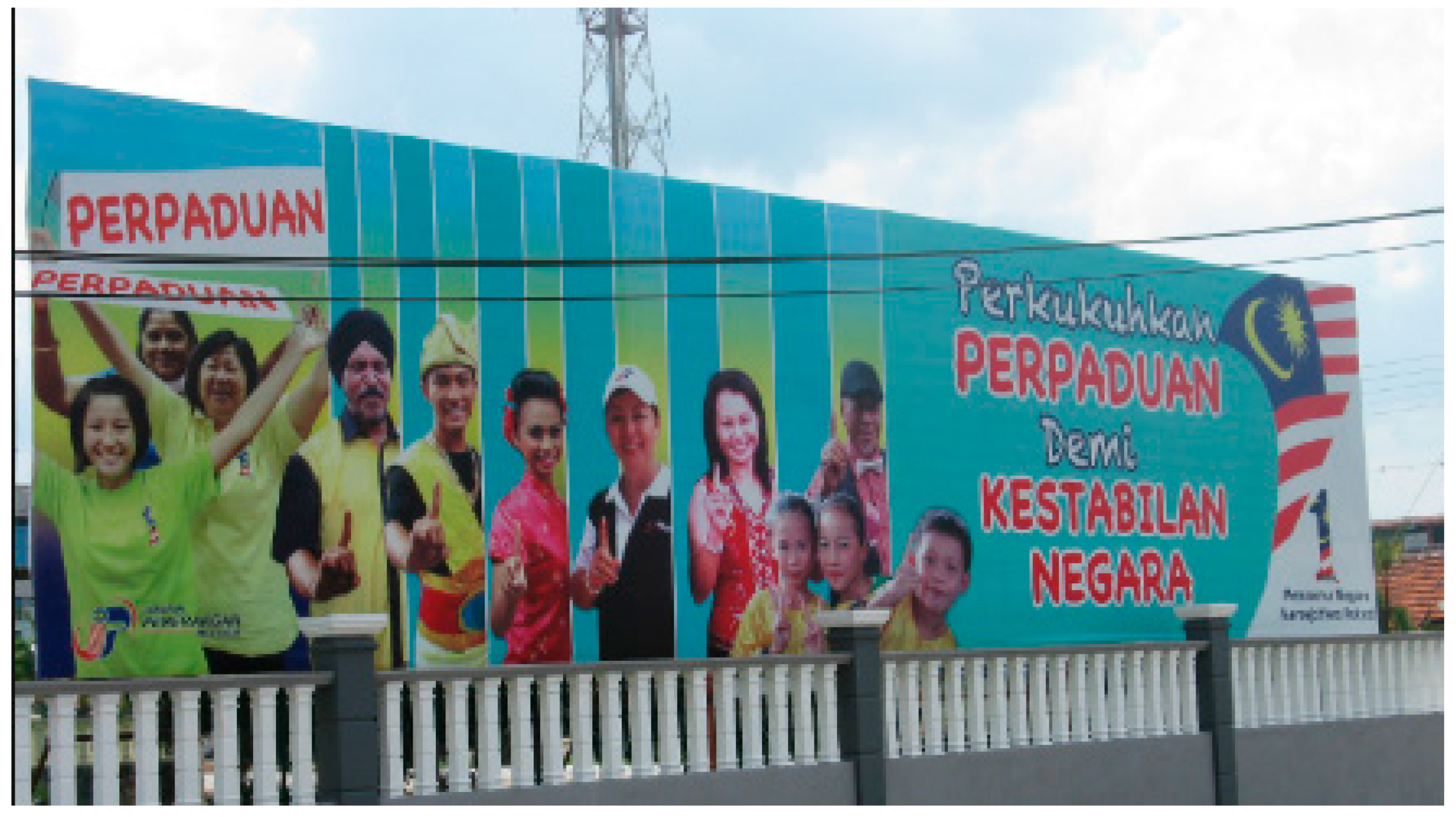
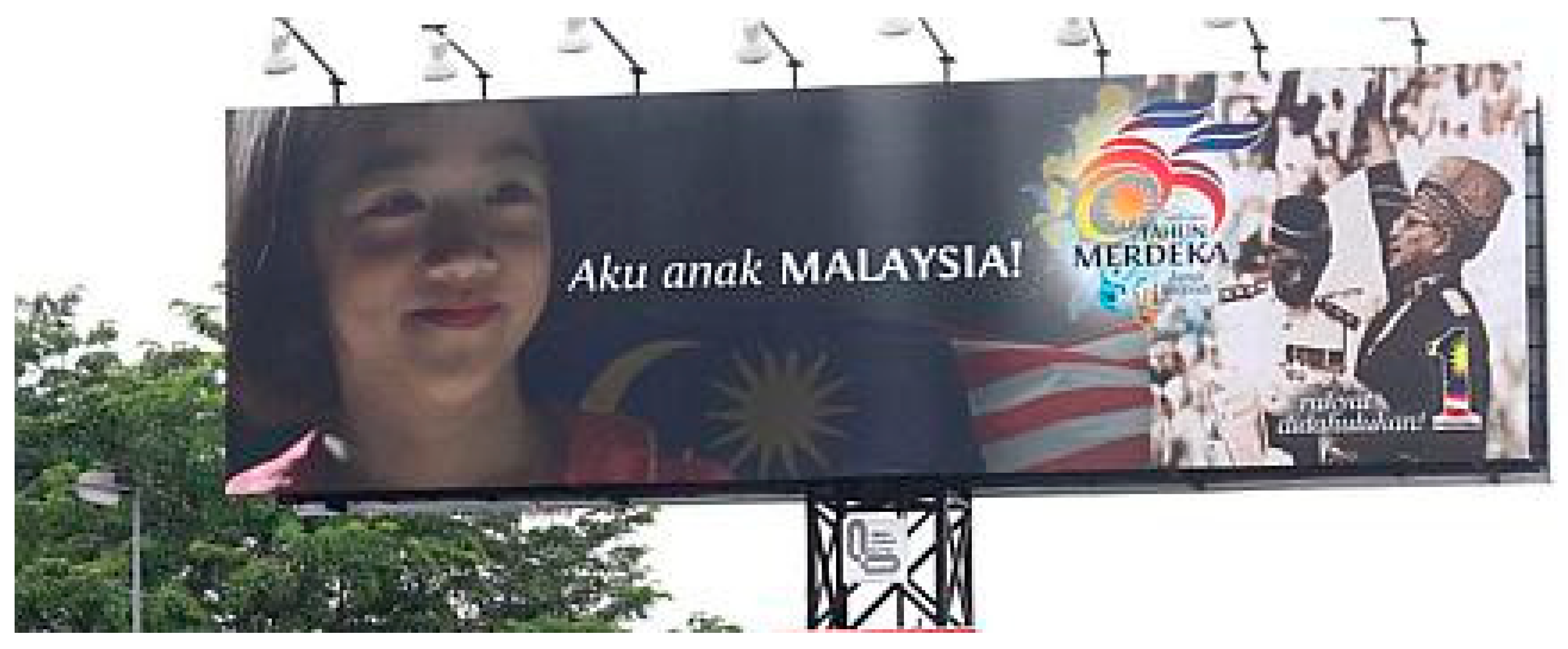
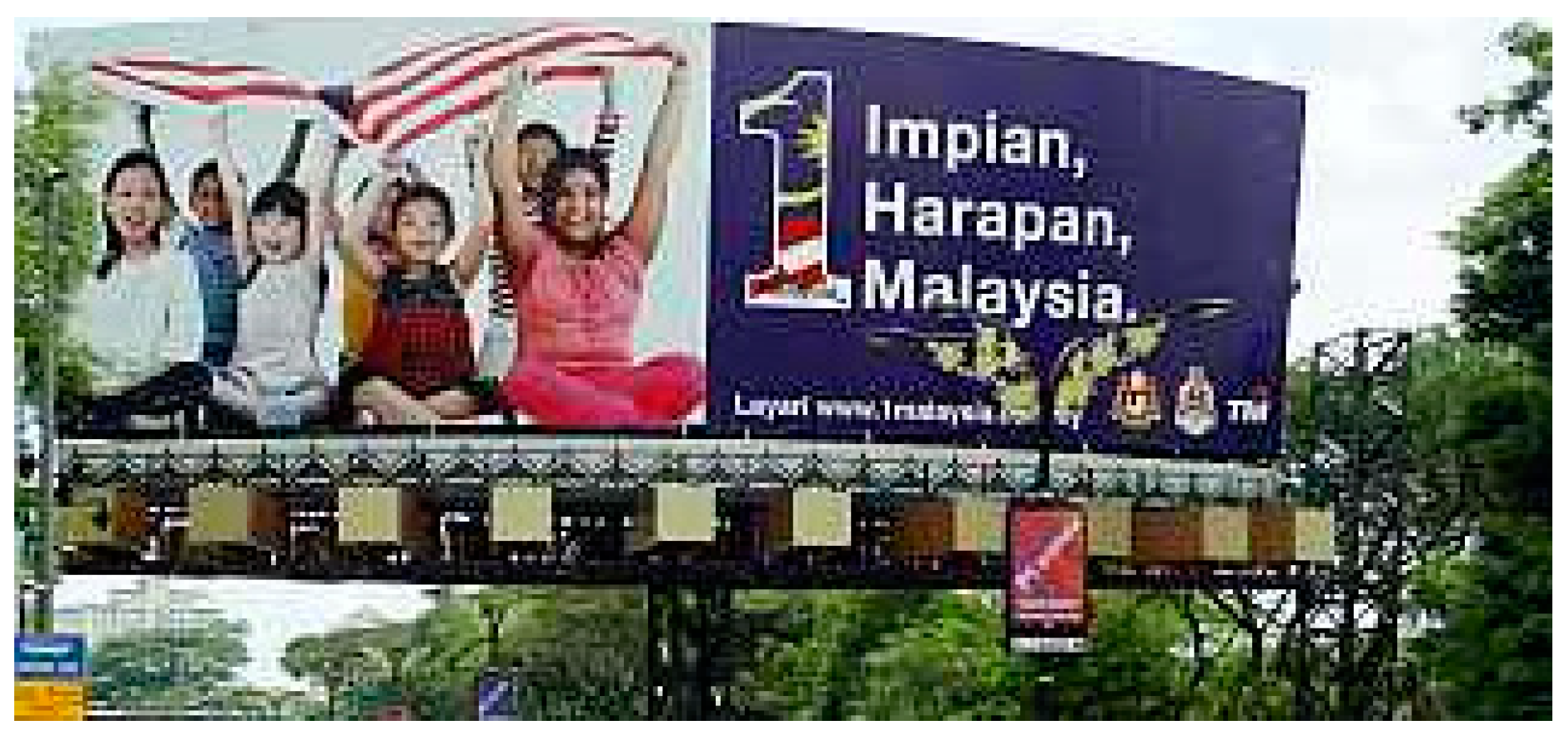
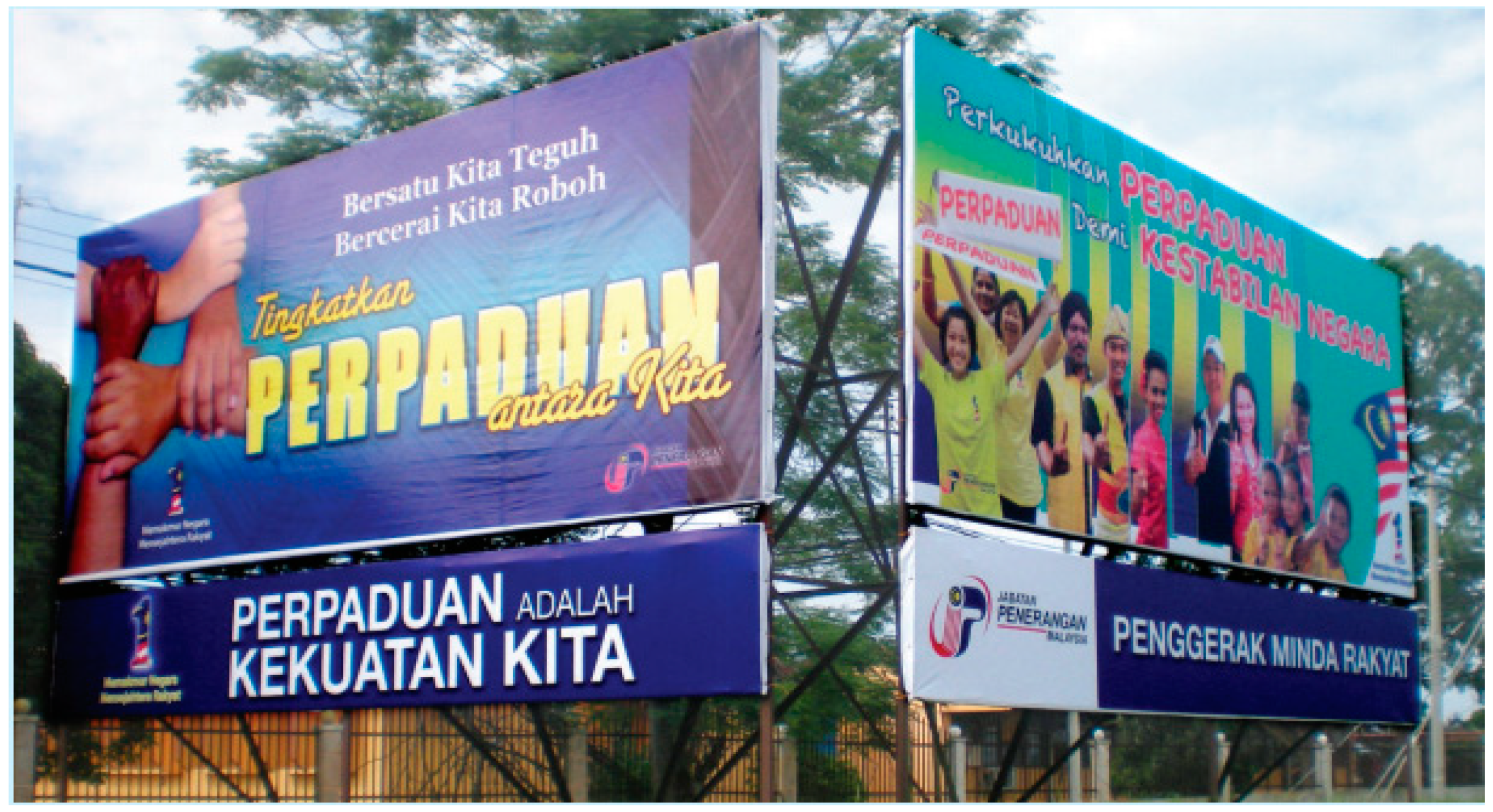
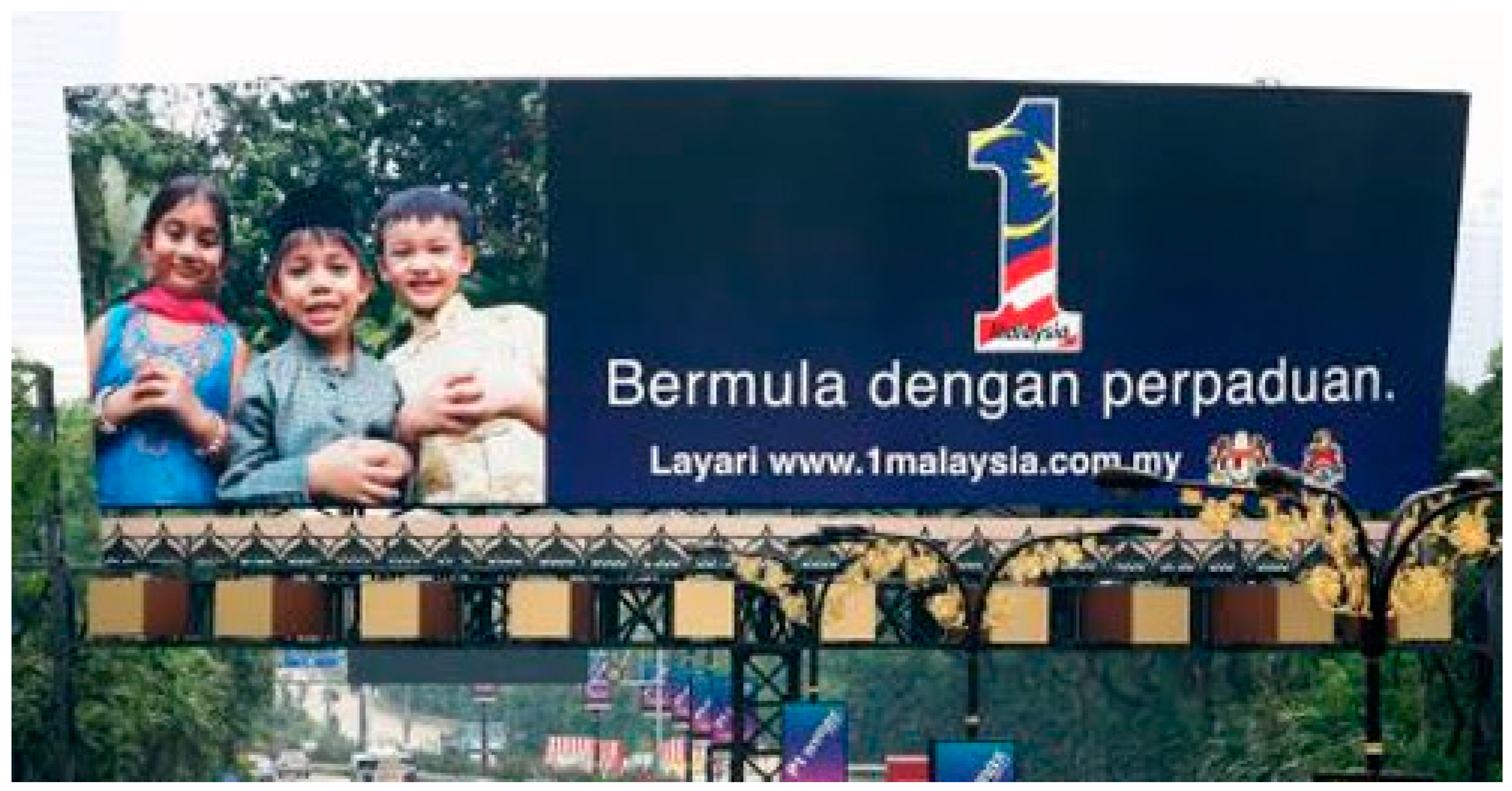
© 2019 by the authors. Licensee MDPI, Basel, Switzerland. This article is an open access article distributed under the terms and conditions of the Creative Commons Attribution (CC BY) license (http://creativecommons.org/licenses/by/4.0/).
Share and Cite
Ahmad Tajuddin, S.N.A.; Zulkepli, N. An Investigation of the Use of Language, Social Identity and Multicultural Values for Nation-Building in Malaysian Outdoor Advertising. Soc. Sci. 2019, 8, 18. https://doi.org/10.3390/socsci8010018
Ahmad Tajuddin SNA, Zulkepli N. An Investigation of the Use of Language, Social Identity and Multicultural Values for Nation-Building in Malaysian Outdoor Advertising. Social Sciences. 2019; 8(1):18. https://doi.org/10.3390/socsci8010018
Chicago/Turabian StyleAhmad Tajuddin, Siti Nor Amalina, and Noraini Zulkepli. 2019. "An Investigation of the Use of Language, Social Identity and Multicultural Values for Nation-Building in Malaysian Outdoor Advertising" Social Sciences 8, no. 1: 18. https://doi.org/10.3390/socsci8010018
APA StyleAhmad Tajuddin, S. N. A., & Zulkepli, N. (2019). An Investigation of the Use of Language, Social Identity and Multicultural Values for Nation-Building in Malaysian Outdoor Advertising. Social Sciences, 8(1), 18. https://doi.org/10.3390/socsci8010018



